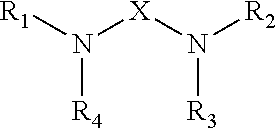Epoxy Resin Compositions
a technology of epoxy resin and composition, applied in the field of epoxy resin composition, can solve the problems of large increase in the viscosity of the formulation, acetone and methanol can disturb the crosslinked network, and difficulty in processing
- Summary
- Abstract
- Description
- Claims
- Application Information
AI Technical Summary
Problems solved by technology
Method used
Image
Examples
example 1
[0077]Preparation of compositions. Primary curing agent (cycloaliphatic amine) compositions were formulated with various secondary curing agents (imidazoles) to make the liquid curing component used according to this disclosure.
TABLE 1SecondarySecondaryPrimaryCuringCuringFinal formFormu-CuringAgentMixingAgentafter 30lationAgentImidazoletemp ° C.solubilitydays1PACM00NALiquid2PACMAMI-150CompletelyLiquidsoluble3PACMAMI-2100Partiallyhazy liquidsoluble4PACMEMI-2450CompetentlyLiquidsoluble5PACM2MZ Amize100PartiallyHazy liquidSoluble
[0078]In Table 1, 4,4′-methylenebiscyclohexanamine (PACM) was used as a primary amine and mixed with various accelerators which were added to determine their solubility in that PACM. It is desirable to use formulated curing agents in a liquid form for composite applications. Commercial imidazoles are either sold in a liquid or solid form. The solubility of liquid accelerators was very good in PACM that means liquid accelerators will have good compatibility with...
example 2
[0079]Several curing agent formulations were prepared. PACM was used as a primary curing agent and 1-methyl imidazole (AMI-1) was utilized as secondary curing agent. Both products were mixed in the amount shown in Table 2. To facilitate mixing, both the PACM and the AMI-1 were preheated separately at 50° C. for 1 hour. Formulations 1-9 were mixed with magnetic stirrer at 1000 rpm at 50° C. for 1 hour. Resulting formulations were used to cure epoxy resin (epoxy equivalent weight (EEW) 180) at varied stoichiometric ratios. A small percent of polyether amines were also considered in some formulations (Formulations 6 and 9) to analyze the effect on thermal and impact properties.
[0080]Formulations 1-3 are comparative examples wherein Formulation 1 is liquid epoxy resin (LER) (EEW 180) with PACM and Formulations 2 and 3 are 80:20 and 70:30 mixture of EPON® 826: DER 438, respectively. EPON® is a registered trademark of Hexion Specialty Chemicals, Inc.
[0081]The epoxy component and amine cur...
example 3
[0086]A similar approach to Example 2 was utilized in Example 3 but with a 2-ethyl 4-methyl imidazole (EMI-24) as secondary curing agent. The results are reported in Table 3. Formulation 10, which contains 2 parts of EMI-24, provides a desirable Tg at 171° C. In Examples 11 and 13, longer chain polyether amines poly(alkylene oxide) were added to the formulation to modify the structural performance, which resulted in little or no alteration of the thermal properties.
TABLE 3Table 3 Curing agent formulation with EMI-24Formulation12310111213PACM10010010098939894EMI-24———2221D2000————2.52.5T5000————2.52.5LER EEW-1801008070100100100100DER 438—2030Phr29292924242626Tg C. (ISO)160167175171172167170Gel time @ 25 C.214144125185196194197(150 gms mass)Time to 10,000 cps @9474669495949640 C.Mix vis @25 C. with517715831587595539567EEW180Mechanical PropertiesTensile Strength(psi)9,7268,1468,6587,8639,8539,1979,525Tensile Modulus (psi)251,000297,000304,000290,000287,000276,000282,354% Elongation5.54...
PUM
| Property | Measurement | Unit |
|---|---|---|
| Fraction | aaaaa | aaaaa |
| Fraction | aaaaa | aaaaa |
| Fraction | aaaaa | aaaaa |
Abstract
Description
Claims
Application Information
 Login to View More
Login to View More - Generate Ideas
- Intellectual Property
- Life Sciences
- Materials
- Tech Scout
- Unparalleled Data Quality
- Higher Quality Content
- 60% Fewer Hallucinations
Browse by: Latest US Patents, China's latest patents, Technical Efficacy Thesaurus, Application Domain, Technology Topic, Popular Technical Reports.
© 2025 PatSnap. All rights reserved.Legal|Privacy policy|Modern Slavery Act Transparency Statement|Sitemap|About US| Contact US: help@patsnap.com



